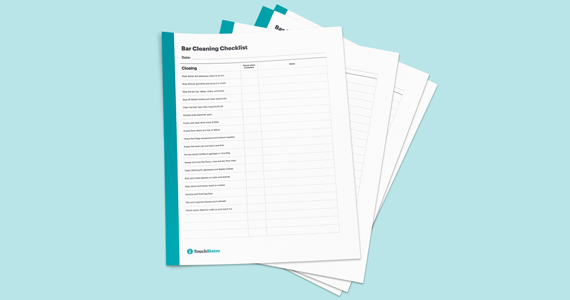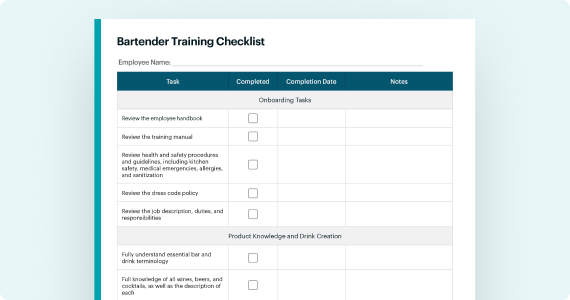Not sure how to become a bartender?
We’ve got you covered (and no, you don’t have to go to bartending school).
Creating magical cocktails. Soaking up the social atmosphere. Chatting with guests from all walks of life. Putting a smile on someone’s face. Any way you slice it, bartending is a tempting career.
But becoming a bartender can feel like an impossible task:
“Should I attend bartending school?”
“Do I skip school and get some work experience instead?”
“What about a bartender’s license?”
The good news? Becoming a bartender is easy if you use these 17 “how to become a bartender” tips.
Tips on How to Become a Bartender & Get Experience
From tips on understanding the bartending business to developing your skills to getting your first job — we cover it all.
Regardless of your chosen occupation, it’s always a good idea to understand what your job involves.
For bartenders, this includes:
- Knowing what duties you’re expected to perform
- Learning the pros and cons of the job
- Diving into the bartending culture
- Understanding your earning potential

Start With the Bartending Basics
1. Know What You’ll Have To Do
The first thing you need to know is that bartending isn’t all glamour. Second, the job almost always includes the following duties:
- Taking orders
- Pouring drinks
- Greeting and chatting with customers
- Providing customers with menus
- Creating cocktails
- Checking IDs to make sure customers are of legal age
- Cleaning the bar (and cleaning it again!)
- Maintaining stock levels
- Accepting payments through your POS
- Monitoring intoxication levels

Use this customizable bar cleaning checklist to keep your restaurant bar looking spotless.
2. Bartending Pros and Cons
We’ve mentioned the perks of bartending. But, like every job, there are also downsides to the role.
Compare the following pros and cons to decide if bartending is right for you:
- Bartending can be mentally taxing.
- Bartending is physically demanding.
- You’ll work in a demanding, high-pressure environment.
- You’ll work late nights – and your weekends won’t be your own.
- Work can be boring and monotonous.
3. Immerse Yourself in Bar Culture: See How the Pros Do It
You’ve been to scores of bars, but have you really paid attention to the operation?
Learn about bartending without ever getting your hands dirty by visiting your favorite bar. Here’s how.
Order a few drinks. See how the bartender makes them and works with other restaurant staff. Watch what they do between drinks to keep operations humming. Notice how the bartender interacts with customers, too.
4. Know Your Earning Potential
As a bartender, your salary depends on many factors: the minimum wage in your state, individual tips, shared tips, the type of establishment you work in, and your skill level and seniority.
Salaries can be as high as $132,000 per year for highly skilled bartenders or as low as $11,000 for junior ones.
That being said, there are certain averages you can use as a guideline. Here are average bartender salaries by state, year, hour, and month:
- State: Tipped wages vary from $3.52 in Michigan to $13.25 in Washington, D.C. The State of Tipped Minimum Wage in the Restaurant Industry has a full breakdown by state, but it’s always a good idea to check with your local Department of Labor for any changes.
- Year: $23,039
- Hour: $11.00
- Month: $1,920
Build Your Bartending Knowledge
The more you know before you jump in, the better equipped you’ll be on the job.
You can get this information while working in bars, but it doesn’t hurt to improve your skills in your spare time.
5. Know the Bartender Lingo
Knowing bartending language will make your job easier. Do you know these terms?
- Back: A small glass of something served with a drink
- Chaser: A drink consumed shortly after having a shooter
- Dash: A small drop or amount of ingredient (e.g. a bloody mary with a dash of Tabasco)
- Dirty: The inclusion of olive juice in a martini
For more bartender lingo, check out this comprehensive list of bar terms. You should also stay on top of new terms such as angel shot.

Use this checklist to help streamline the training process for new bar staff and set them up for success.
6. Dip Into Different Cocktails
Beyond knowing the lingo and learning how to make popular drinks and cocktails like martinis – consider specializing in something.
For example, you might focus your talents on one type of alcohol like whiskey, and develop your cocktail knowledge and drink-making ability around it. This knowledge will help you:
- Whip up custom cocktails on request
- Differentiate yourself from the other bartenders
- Earn more money
7. Go to Bartending School (Or Not)
Let’s get this out the way.
You don’t have to attend bartending school to become a bartender. You do not need formal education because you’ll learn the majority of your skills on the job.
If you do opt for the school route, you’ll get to learn the basics of bartending in a structured way without having to find this information yourself. For instance, you’ll learn different pouring techniques and even how to craft the perfect cocktail.
But, bartending school does not guarantee job placement, and you won’t suddenly be able to handle a busy night. Bartending school can also be expensive. Basic online courses can cost up to $200 and in-class sessions anywhere up to $600. For example, the New York Bartending School costs $595 for a 40-hour class.
Ultimately, the decision is yours and will depend on your goals. You can always start out by getting a job in a bar – working as a barback to help replenish the bar inventory, bus glasses and plates, and clean the bar area – just to get some experience first.

Use this customizable bar cleaning checklist to keep your restaurant bar looking spotless.
8. Borrow From Successful Bartenders
This could be as simple as visiting your local pub to watch what the bartender does, ask questions, and learn about bartending skills and culture.
But why not take things a step further?
Tell the bartender that you want to become one and want to learn more about how they got into the business. What were the exact steps they took to get their job?
You’d be surprised how many people like to talk about their own careers and are happy to share information with those who are really interested in learning more. People love sharing their stories and talking about themselves.
Understand State Laws
Age requirements for serving alcohol and certification differs by state.
9. Are You Old Enough?
The alcohol serving age is between 18 and 21 in the U.S. Be sure you know the age requirement for servers (not drinkers!) in your state.
For example, in New York it’s 18, but in California, 21. Here is a breakdown (by state) of how old you need to be to serve alcohol.
10. Do You Need Certification?
Most states don’t require you to have any licenses or certificates, but there are a few places where a certification course is required
In Washington, for example, you have to complete an alcohol serving course and obtain a permit.
Check the requirements by contacting the liquor control board in your state. Below are the liquor control boards of New York, California, and Illinois:
- New York: New York State Liquor Authority
- Illinois: Illinois Liquor Control Commission
- California: California Alcoholic Beverage Control
In Ontario, Canada, everyone involved in serving alcoholic beverages must pass a short online course called Smart Serve. The program trains restaurant and bar staff in responsible alcohol consumption and service.

Sharpen Your Skills
Becoming a successful bartender requires a shot of hard skills and a shot of soft.
11. Building Your Hard Skills
Hard skills are the ones that are teachable, like measuring and pouring drinks, creating cocktails, processing orders, and keeping inventory. You can learn these skills on the job or in school.
12. Sharpen Your Soft Skills
Soft skills are harder to define, hard to measure, and even harder to teach.
Here are three critical soft skills you’ll need to be a good bartender:
- Social skills. You’ll spend lots of time interacting with colleagues and customers, so this is probably one of the most important skills. Plus, you’ll be working in a very social environment, so you’d better love interacting with people. For some great tips on having better conversations at the bar, read Bartending 101: Conversation Do’s and Don’ts for Bartenders.
- Multi-tasking skills. You’ll be serving many guests at a time, which means you have to remember plenty of orders — all while interacting with staff, monitoring the bar, processing orders, and keeping customers happy.
- Communication skills. You’ll have to speak clearly and openly (and probably very loudly!) to your customers and colleagues during your shift to keep things running smoothly. Good communication is key to efficient operations – not to mention getting the right drink to the right customer.
Get Your First Bartending Job
By now you should have a pretty good idea what bartending involves, understand the state laws, and know something about the different skills you need.
TIP: it’s highly unlikely a restaurant will hire you as a bartender without any previous experience. Instead, expect to start as a barback. A barback is basically the assistant bartender who helps refill inventory, clean the bar area, and support the wait staff.

Use this checklist to help streamline the training process for new bar staff and set them up for success.
13. Write a Solid Bartender Resume
Writing a strong resume is key to getting a job and it’s easy if you follow these tips:
- Keep it short (one to two pages). Managers usually do a quick scan to decide if you’re a fit.
- Make sure there are no spelling mistakes.
- Highlight details that show your ability to bartend. Include any serving experience or other experiences that help convince the manager you have the soft skills you need.
- Make sure details are accurate. Be honest.
- Include certifications and bartending courses.
- Be sure they can contact you! Don’t forget your email and phone number.
14. Gain Experience By Finding Work
Finding work can be hard, but if you know where to look and you’re flexible, you’ll improve your chances of getting a job. Here are three ways to find work:
- Ask for a referral: Let family and friends know you’re looking and ask if they can open a door for you.
- Drop off method: Drop off your resume personally at your local bar or restaurant during quieter times when managers aren’t busy dealing with customers.
- Use job sites: Indeed, Craigslist, and other large job boards are a good place to start. Specialized job sites like GoodFoodJobs.com are another resource to try. Thousands of applicants use these sites every day so be prepared for stiff competition.
15. Get the Interview
Once you get that response, it’s time for the interview. Yes, this can be a little scary, especially if you’ve never had an in-person interview before. The trick is to prepare. Here’s how:
- First, visit their website. Understand their brand and the customers they attract.
- Study the wine list and the drinks they serve.
- Know what interview questions to expect and prepare answers. A common question is, “Why do you want to work here?” Be prepared to talk about your past experiences and why you’re interested in their business.
16. Show Up For the Trial Shift
It’s common to be asked to work a trial shift on your way to getting the job. This is your chance to show them that you bring solid skills to the job – and that you’re coachable and willing to learn how they do things. The manager will tell you what you need to bring and wear, as well as when to arrive. Be there on time and be prepared to work.

Use this customizable bar cleaning checklist to keep your restaurant bar looking spotless.
17. Become a Barback to Make The Transition
If the trial shift goes according to plan, you’ll likely start as a barback, the bartender’s assistant. It’s possibly the best way to learn about bartending and how to run a successful bar.
The other upside is that when the hiring manager needs a new bartender, you’ll be at the top of the list. You’ll know how their restaurant and bar works, and when that moment comes, you’ll be ready.
Getting into a new industry takes some work and preparation. But armed with these 17 tips, you now have a better idea of how to become a bartender.
Download your free employee handbook template
Sign up for our free weekly TouchBistro Newsletter







